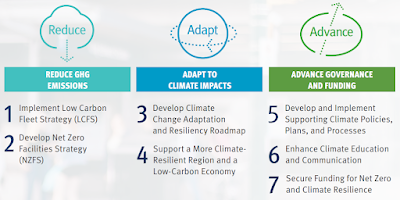TransLink staff will present their Climate Action Plan to their board on Thursday. The plan is based on the objectives to achieve net-zero greenhouse gas (GHG) emissions by 2050, with an interim reduction of 45% from 2010 levels by 2030 and to ensure that its infrastructure and operations are resilient to the impacts of climate change.
TransLink will replace its current non-electric fleet with battery-electric buses and renewable natural gas buses to reduce GHG emissions. This change is already starting with Route 100, scheduled to be fully battery-electric by 2024. TransLink will also pilot renewable diesel buses.
TransLink also operates significant maintenance, control and storage facilities and will implement a Net Zero Facilities Strategy.
We are already seeing the impacts of climate change today. By 2050, we will see longer, more extreme heat waves, heavier rain and snow events, increased flooding, rising sea levels, and more storms.

|
| An extreme snow event impacted the 555 bus route. |
The Climate Action Plan outlines the infrastructure most at risk due to climate change, such as power substations, tunnels, bus maintenance and storage facilities, bridges, bus loops, and stations. TransLink will complete climate change risk assessments for all its infrastructure and processes and then incorporate mitigation measures into its operating procedures, asset management plans, and renewal plans.

|
| TransLink’s seven-point Climate Action Plan. Select image to enlarge. |
With hotter summers, TransLink will need to ensure that heat stress impacts are reduced for its staff. As such, it will research the “efficacy and feasibility of personal cooling technology and revised uniform specifications for Technician, SkyTrain Attendants, Operators, and Transit Police.”
TransLink will also improve cooling for its customers and start implementing shading infrastructure, such as cooling/misting systems and shade trees, in partnership with local governments. They will also update their Transit-Oriented Communities Design Guidelines through the lens of climate resilience.
Partnership is essential. TransLink will work with Indigenous peoples, local governments, the provincial government, the federal government, and the private sector to advance climate change adaptation and mitigation measures.
These actions are a small sample from the plan. You can read the complete plan in the December 1st TransLink Board Meeting Agenda.

TransLink and BC Transit are way behind other major transit systems in Alberta, Ontario and Quebec. As well as many other systems around the world.
ReplyDelete